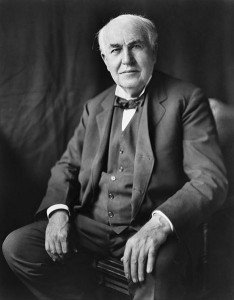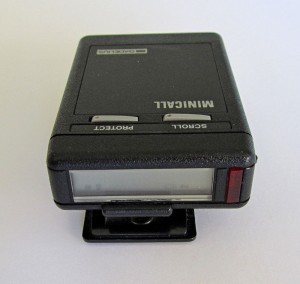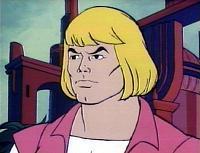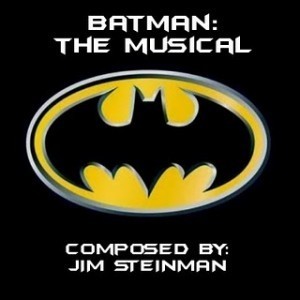Bathroom Readers' Institute's Blog, page 164
July 29, 2013
Almost Famous
What if you were a talented musician, so good that you got a record. Now, what if you had a relative that was also good…but maybe a little bit better, and they got incredibly famous? Here are a the stories of the almost famous.
STEVE YOUNG
Starfighters were a British heavy metal band that formed in the late ‘70s. Despite having released one single called “I’m Falling” that didn’t sell very well, they were signed by the manager of the popular British heavy metal group Krokus and got a spot as the opening act on tour for AC/DC in 1981, one of the world’s most popular bands at the time. How did they pull that off? The Starfighters’ lead guitarist, Steve Young, is the nephew of Angus and Malcolm Young of AC/DC. Starfighters released two albums in the ’80s, and when Uncle Malcolm briefly left AC/DC in 1988 to check into alcohol rehab, Steve Young filled his spot. What did Starfighters sound like? If songs like “Alley Cat Blues” are any indication…a lot like AC/DC.
MICHAEL McCARTNEY
If you had a famous last name or were related to one of the most famous people in the world, you’d probably want to find your place in the world on your own merits, without leaning on the name. That’s exactly what Michael McCartney did. He’s Paul McCartney’s little brother, and he’s had a relatively successful music career. You’ve never heard of him because professionally he uses the name Mike McGear. In the ‘60s he was in a comic band called Scaffold, which had a #1 hit in England in 1968 called “Lily the Pink.” As a solo artist, he released a string of albums, the last in 1974. McGear is now a photographer…just like his brother’s first wife, Linda McCartney.
LIVINGSTON TAYLOR
 James Taylor defined the smooth, laidback, “singer-songwriter” sound of the early 1970s. Lots of people who collaborated with Taylor went on to successful careers in music, including Carly Simon, Jackson Browne, and his own brother, Livingston Taylor. He’s released more than 15 albums of soft rock, and had a top 30 hit in 1978 called “I Will Be in Love With You.” James Taylor even once covered Livingston’s song, “Going Round One More Time”— so no sibling rivalry there.
James Taylor defined the smooth, laidback, “singer-songwriter” sound of the early 1970s. Lots of people who collaborated with Taylor went on to successful careers in music, including Carly Simon, Jackson Browne, and his own brother, Livingston Taylor. He’s released more than 15 albums of soft rock, and had a top 30 hit in 1978 called “I Will Be in Love With You.” James Taylor even once covered Livingston’s song, “Going Round One More Time”— so no sibling rivalry there.
July 26, 2013
An Odd Holiday: Aunt and Uncle’s Day
Finally, a holiday just for Uncle John. And Mrs. Uncle John! Happy Aunt and Uncle’s Day!
You’re familiar with Mother’s Day and Father’s Day, and hardworking moms and dads certainly do deserve their holidays. There’s a National Grandparents Day (it’s in September, and not widely celebrated). And in 2001, President Bush declared June 4 “National Children’s Day.” (Although Uncle John’s mom always said “everyday is children’s day”…with a groan.)
But what about the people who don’t have kids of their own but positively worship their brothers’ and sisters’ kids? Where is the day of recognition for the loyal souls who send birthday cards with a $10 bill tucked inside and who “like” all of the niece and nephew baby pics on Facebook?
 Aunt and Uncle’s Day is finally here. This still-unofficial holiday falls on the last Friday of July—right in the middle of family vacation road trips to visit relatives—and this year, that’s today. Oddly, very little information seems to exist on who came up with Aunt and Uncle’s Day. A petition on Facebook to make it an officially recognized holiday on par with Mother’s Day or Father’s Day has only around 100 likes as of press time. But even though Hallmark doesn’t sell Aunt and Uncle’s Day cards, and no retail chain is urging you to buy the perfect gift for your fun uncle or cool aunt, you can still make a phone call…or send a card with a $10 bill tucked inside.
Aunt and Uncle’s Day is finally here. This still-unofficial holiday falls on the last Friday of July—right in the middle of family vacation road trips to visit relatives—and this year, that’s today. Oddly, very little information seems to exist on who came up with Aunt and Uncle’s Day. A petition on Facebook to make it an officially recognized holiday on par with Mother’s Day or Father’s Day has only around 100 likes as of press time. But even though Hallmark doesn’t sell Aunt and Uncle’s Day cards, and no retail chain is urging you to buy the perfect gift for your fun uncle or cool aunt, you can still make a phone call…or send a card with a $10 bill tucked inside.
July 25, 2013
Thomas Edison vs. The Elephant
In 1903, Thomas Edison used 6,600 volts of electricity to kill an elephant. Why? Because he was kind of a jerk. But more than that, he was concerned about losing the “War of Currents” to his rival, George Westinghouse.
 By the beginning of the 20th century, electricity was spreading to homes and businesses across America. The preferred method was AC, or “alternating current” electricity, devised by entrepreneur George Westinghouse. One guy not too happy about that: Thomas Edison, who came up with DC, or “direct current” electricity. Edison was still unwilling to accept his defeat and wanted to stage a publicity stunt to prove that his method was the superior method.
By the beginning of the 20th century, electricity was spreading to homes and businesses across America. The preferred method was AC, or “alternating current” electricity, devised by entrepreneur George Westinghouse. One guy not too happy about that: Thomas Edison, who came up with DC, or “direct current” electricity. Edison was still unwilling to accept his defeat and wanted to stage a publicity stunt to prove that his method was the superior method.
Edison went about promoting DC power, and showing that it was safe and effective, in a very bizarre way—he’d publicly electrocute animals. Through the 1890s and into the 1900s, Edison killed cats, horses, an orangutan, and once helped the state of New York execute a convicted ax murderer.
But the pinnacle of Edison’s peculiar crusade was the execution of Topsy, a 28-year-old elephant who had killed three people and had to be put down. Topsy hadn’t actually killed those three people, though. She’d acted in self-defense, stomping an abusive trainer who, among other brutal acts, tossed a lit cigar into her mouth. Nevertheless, 1,500 spectators came out to Luna Park on Coney Island in January 1903 to witness Topsy’s execution.
Topsy was first fed carrots laced with potassium cyanide (a “backup” in case the execution didn’t work), before Edison hooked her up to a series of electrodes. He flipped the switch and down poor Topsy went.
And what was the aftermath? Did Edison prove once and for all the greatness of DC power by using it to kill one of nature’s most powerful beasts? Not exactly—AC remained the industry standard. One hundred years after the Topsy event, in 2003, a memorial to the elephant opened on Coney Island. There’s another memorial. Edison, one of the pioneers of motion pictures, filmed the execution. Title: “Electrocuting an Elephant.” Here is the link to the video…but be warned…it’s pretty sad and gruesome.
July 24, 2013
Beep Me! (Beeper Codes)
Before email, cell phones, and text messaging, people had to instantly communicate with beepers. And a secret language of beeper codes.
 From the mid-‘90s to the early 2000s, before cell phones became ubiquitous, the best, cheapest way for parents to keep track of their teenagers, and for teenagers to keep track of each other, were beepers, or pagers. Here’s how it worked: From any phone, you’d dial a friend’s beeper number. They’d receive a simple text message on their pager’s display: your number, and any other numbers you wanted to include. For example: “911” would mean “call me right now – it’s an emergency.”
From the mid-‘90s to the early 2000s, before cell phones became ubiquitous, the best, cheapest way for parents to keep track of their teenagers, and for teenagers to keep track of each other, were beepers, or pagers. Here’s how it worked: From any phone, you’d dial a friend’s beeper number. They’d receive a simple text message on their pager’s display: your number, and any other numbers you wanted to include. For example: “911” would mean “call me right now – it’s an emergency.”
From that spawned a new language of beeper codes. Those little coded messages became both a shorthand, a way to actually communicate via the very limited capacity of a pager, and also a way to shut out uninformed, nosey parents. Here are some of those old beeper codes. (While some of them make perfect sense, others seem quite random. But who can understand these kids today…or yesterday?)
0001000 – “I’m alone” (see the “1” all by itself?)
0099 – “We’re going out, do you want to come?”
04*04*04 – “Merry Christmas” (flip the pager upside-down and it reads “ho ho ho”)
05*05 – “We’re going out for margaritas!” (5/5 = May 5th = Cinco de Mayo = margaritas)
1*800 – “No plans tonight” (1-800 means “I’m free,” get it?)
10000 – “Let’s go swimming” (10000 as in 10,000 Leagues Under the Sea)
11111111 – “Congratulations” (it looks like a string of exclamation points)
90210 – “What a snob”
333 – “What’s up?”
411 – “Give me information”
420 – “I’m in big trouble”
87 – “Running late” (upside-down, the 7 looks like an L, so together, it’s “L8”)
9*5 – “I just got off of work”
555 – “Call me” (after the phony “555” prefix used for phone numbers in movies)
710 – “I’m out of gas” (upside-down it looks like the word “oil”)
143 – “I love you” (one letter in “I,” four in “love,” three in “you”)
1423 – “I want to die” (one letter in “I,” four in “want,” 2=to, three letters in “die”)
811 – “Not quite an emergency, but pretty important”
July 23, 2013
Weird Invention: Hot Toilet!
As we can all agree, the toilet is mankind’s greatest achievement. But even perfection can be improved upon. Maybe it is time to reinvent the toilet.
 A team comprised of researchers from Duke University and the University of Missouri are hard at work on a project that could forever change toilets as we now know them. Based around a technology called “supercritical water oxygenation,” the team is building a toilet that can convert human waste into heat…and clean water.
A team comprised of researchers from Duke University and the University of Missouri are hard at work on a project that could forever change toilets as we now know them. Based around a technology called “supercritical water oxygenation,” the team is building a toilet that can convert human waste into heat…and clean water.
Here’s how it works. After receiving a “deposit” of “fresh waste material,” the toilet heats a small amount of water to an extremely high temperature (over 700°F.). Organic substances dissolve, and what’s left of the waste is heat, carbon dioxide, and water. It’s not quite potable (and we’re not sure we’d drink it even if it was), but that water—which was otherwise flushed away forever—can be used for everything from showering to washing dishes.
The team’s ultimate goal is to build a self-sustaining system (meaning it would use its own heat to heat the next batch of supercritical water) that can fit in a 20-foot storage container at a water treatment facility and filter the combined waste of around 1,200 people. While their system might not be practical for a new bathroom at your house, it could be a game-changer for the billions of people on the planet who don’t have access to proper sanitation.
The project is the latest in the Reinvent the Toilet campaign, funded by the Bill & Melinda Gates Foundation. Over the past few years, other researchers from the foundation for things like a solar-powered toilet, and one that creates charcoal out of human waste.
July 22, 2013
Comic-Con 2013 Recap in Pictures
This weekend, pop culture fans gathered in San Diego for Comic-Con 2013 and stood in long lines to get the latest on upcoming movies, video games, and other comic-related news. We skipped the lines and walked the floor instead. I’m always amazed at the amount of effort people go through for cosplay. Here are a few pictures as proof that we were actually there.

Comic-Con taking over the streets of San Diego

Jack and Sally from "The Nightmare Before Christmas"

Jay and Silent Bob
[image error]
Merv Pumpkinhead from "The Sandman"
[image error]
Loki from "Thor." We could swear this was actually actor Tom Hiddleston. The likeness was uncanny.
[image error]
Ash from "Evil Dead"

No Comic-Con is complete without a sighting of Admiral James T. Kirk (William Shatner)

And our favorite: The not-so-dynamic duo
July 18, 2013
Toy Fads: The Saga of the Lost He-Man Action Figure
It’s the rarest action figure of all time…because it didn’t exist.
 He-Man and the Masters of the Universe was the bestselling “action figure” line of the 1980s. From 1982 to 1988, when the toys were produced in conjunction with the Masters of the Universe cartoon series, Mattel sold $1.2 billion worth of “He-Man,” “Skeletor” and dozens of other MOTU action figures. But apparently there was room for more. In 1986, the Masters of the Universe Magazine held a “Create-a-Character” contest. The magazine’s editors would chose five semi-finalists and readers would vote on the winner. The grand prize: a $100,000 scholarship, a trip to Disneyland, and, perhaps best of all, Mattel would make the winning character into an action figure.
He-Man and the Masters of the Universe was the bestselling “action figure” line of the 1980s. From 1982 to 1988, when the toys were produced in conjunction with the Masters of the Universe cartoon series, Mattel sold $1.2 billion worth of “He-Man,” “Skeletor” and dozens of other MOTU action figures. But apparently there was room for more. In 1986, the Masters of the Universe Magazine held a “Create-a-Character” contest. The magazine’s editors would chose five semi-finalists and readers would vote on the winner. The grand prize: a $100,000 scholarship, a trip to Disneyland, and, perhaps best of all, Mattel would make the winning character into an action figure.
The contest winner was 12-year-old Nathan Bitner for his character, “Fearless Photog.” Photog had a camera for a head and used his camera-head to take “photos” of his enemies, which would drain their strength and transfer their image to his chest plate. Bitner got his scholarship and his Disney vacation, but unfortunately, Mattel never followed through with the rest of the bargain. Fearless Photog was never manufactured. (Interestingly, Bitner went on to design other sci-fi characters—in the 1990s, he worked at Bungie, the video game company that developed the five-million-selling Halo.)
The Masters of the Universe line of toys and the He-Man cartoon show celebrated their 30th anniversary in 2012. To commemorate the occasion, Mattel produced a “Masters of the Universe Classics 30th Anniversary” series, a brand new line of action figures based on old characters. But there were two new entries in the series. One was the winner of a brand-new Create-a-Character contest—Castle Grayskullman, by Daniel Benedict. (He entered a total of five characters in the contest.) And the other new one, after 26 years in the making, was Fearless Photog.
July 17, 2013
Sing, Batman, Sing! (Batman Musical)
Amazingly, Spider-Man wasn’t the first comic book superhero to try to
make it on the Great White Way.
 In 2011, the musical Spider-Man: Turn Off the Dark debuted on Broadway and made headlines. Not because it was really good, but because it was an absolute disaster. Actors in the stunt-heavy show routinely suffered injuries, critics savaged it, audience members asked for their money back, and the producers and creators sued each other. Eventually, the lawsuits were settled, safety measures were introduced, the script was rewritten mid-production, and two years later, the show is still running (to packed houses). But it’s amazing that it ever even made it to Broadway, after the failure of a proposed Batman musical.
In 2011, the musical Spider-Man: Turn Off the Dark debuted on Broadway and made headlines. Not because it was really good, but because it was an absolute disaster. Actors in the stunt-heavy show routinely suffered injuries, critics savaged it, audience members asked for their money back, and the producers and creators sued each other. Eventually, the lawsuits were settled, safety measures were introduced, the script was rewritten mid-production, and two years later, the show is still running (to packed houses). But it’s amazing that it ever even made it to Broadway, after the failure of a proposed Batman musical.
In 1997, the Walt Disney company expanded from movies, TV, and theme parks into theater, buying a Broadway theater from which it could stage live musicals based on its animated movies. (Since then, they’ve bought more theaters and have staged critically-acclaimed and highly lucrative shows such as The Lion King, Beauty and the Beast, Mary Poppins, and The Little Mermaid.) Rival entertainment conglomerate Warner Brothers thought that it was a great idea, so in 1998 formed Warner Bros. Theatre Ventures. The goal: make musicals out of its well-known characters. Its first attempt would be an adaptation of Batman.
Warner hired playwright David Ives to write the script (or the “book,” as its called in musical theater). The lyrics and music were to be written by rock songwriter Jim Steinman, best known for being the creative force behind Meat Loaf’s hugely successful Bat Out Of Hell album in 1977. But while Warner wanted to have Batman in front of audiences by 2000, Steinman delayed work to focus on another musical called Dance of the Vampires, based on The Fearless Vampire Killers, a horror movie made by Roman Polanski. It finally opened in 2002 and closed after 56 performances, losing $12 million, at the time the biggest loss in Broadway history.
But four years later, Steinman was finally free to work on Batman. That same year, Warner made a huge announcement: directing the musical would be Tim Burton, who had revived Batman with his films Batman (1989) and Batman Returns (1992), presenting the character as a dark, gothic character, not the campy ’60s Adam West TV Batman audiences were most used to. The films were smash hits, so Burton was naturally Warner’s first choice. But Warner apparently neglected to make one big move before announcing Burton as the director: According to Burton, they hadn’t actually asked him. He denies to this day that he ever said yes, even telling one interviewer that the idea of a Batman musical was like “Batman on Ice.”
Not helping matters was the disappointing performance of the 1997 movie Batman and Robin. That film took a campier tone, like ’60s TV Batman—Arnold Schwarzenegger played the villain Mr. Freeze, and his dialogue mostly consisted of ice puns (“Allow me to break the ice”; “Let’s kick some ice!” “The Ice Man cometh!”). The movie flopped so badly that sequel plans were cancelled. The makers of the Batman musical were stuck—they couldn’t do it fun and campy, and without Burton, they couldn’t do it the dark way. (Besides, another dark musical had recently flopped—Dance of the Vampires.) Warner quietly cancelled plans and refocused their efforts to returning Batman to the big screen, which they did with Christopher Nolan’s Batman Begins in 2005.
Steinman eventually leaked the songs he’d written for Batman online. For a taste of what he had planned, here’s “Catwoman’s Song”:
July 16, 2013
A Random Origin: The Bouncy House
 Bouncy houses or bouncy castles are those big, brightly colored, enclosed trampolines that kids love to jump on at birthday parties, recreation centers, and Chuck E. Cheese. They’re a lot older than you think. American engineer John Scurlock got the idea in 1959. While trying to design a plastic rain cover for tennis courts, he noticed a few of his employees jumping around on one of his prototypes. That goofing off inspired him to create an inflatable floor, purely for recreational purposes. In the ‘60s, with NASA heading for the moon and space-mania at a fever pitch, Scurlock and his wife started a company called Space Walks, rented out the floors as a way to mimic walking on the moon.
Bouncy houses or bouncy castles are those big, brightly colored, enclosed trampolines that kids love to jump on at birthday parties, recreation centers, and Chuck E. Cheese. They’re a lot older than you think. American engineer John Scurlock got the idea in 1959. While trying to design a plastic rain cover for tennis courts, he noticed a few of his employees jumping around on one of his prototypes. That goofing off inspired him to create an inflatable floor, purely for recreational purposes. In the ‘60s, with NASA heading for the moon and space-mania at a fever pitch, Scurlock and his wife started a company called Space Walks, rented out the floors as a way to mimic walking on the moon.
Scurlock’s son Frank logically took the idea from floor to fully enclosed structure. In 1974, he joined the family business and created the Jupiter Jump. It consisted of an inflatable floor and columns that supported net walls allowing air to pass through—and the bouncers inside from falling out. Children’s birthday parties were never the same.
July 15, 2013
Fast Food Flops
Spinoffs are common in entertainment: Puss in Boots was a spinoff of a character from the Shrek movies, and All in the Family spun off a number of other hit TV sitcoms, including Maude and Good Times. Spinoffs are a lot less common in the fast food restaurant business. But in the late 1960s, two successful fast food chains tried to expand with new restaurants serving completely different food. The result: fast food flops.
 Flop #1. After founder Harlan Sanders sold Kentucky Fried Chicken and allowed it to be aggressively franchised in the early 1960s, the chain’s popularity grew just as fast. By 1968 it was the sixth-largest restaurant chain in America and worth hundreds of millions of dollars. Rather than saturate the market with even more KFC locations, the company opted to start a second restaurant chain: Kentucky Roast Beef & Ham. The new chain sold all the standard KFC side dishes. But instead of chicken, they served roast beef and ham. Launched in 1968, all the roast beef and ham restaurants were converted into chicken joints by 1973.
Flop #1. After founder Harlan Sanders sold Kentucky Fried Chicken and allowed it to be aggressively franchised in the early 1960s, the chain’s popularity grew just as fast. By 1968 it was the sixth-largest restaurant chain in America and worth hundreds of millions of dollars. Rather than saturate the market with even more KFC locations, the company opted to start a second restaurant chain: Kentucky Roast Beef & Ham. The new chain sold all the standard KFC side dishes. But instead of chicken, they served roast beef and ham. Launched in 1968, all the roast beef and ham restaurants were converted into chicken joints by 1973.
Flop #2. In February 1970, Taco Bell announced that after having successfully Americanized (and franchised) Mexican food, it would take on another regional cuisine: barbecue. Founder Glen Bell called it “Hickory Bell” and offered franchises to existing Taco Bell franchisees. Despite Western-themed interiors like wood facades and railings to evoke a Gold Rush-era shack, only three Hickory Bells were ever opened, all in the Los Angeles area. And all of them were later turned into Taco Bells.



